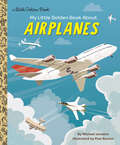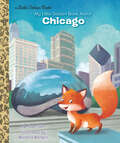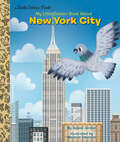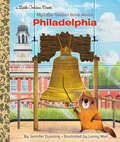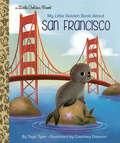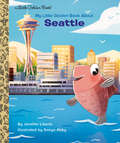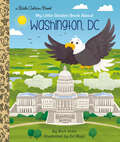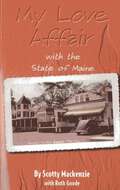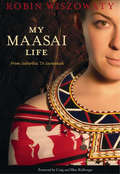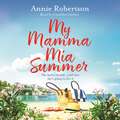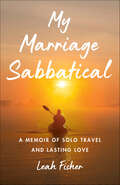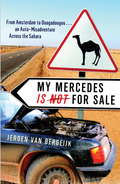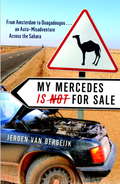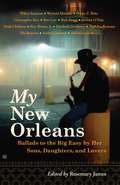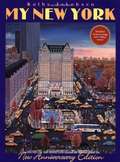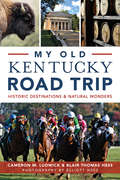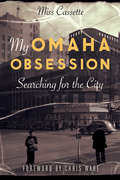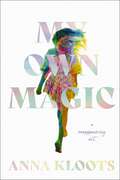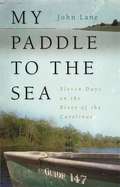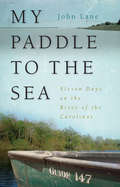- Table View
- List View
My Little Golden Book About Airplanes (Little Golden Book)
by Michael JoostenLittle pilots can learn all about exciting airplanes and famous aviators in this high-flying Little Golden Book!Climb aboard and soar the skies with this adventure-filled look at a subject all children are fascinated by: airplanes! Full of exciting illustrations, simple sentences, and unbelievable facts and stories about some of the most memorable aviators (the Wright brothers, Charles Lindberg, Bessie Coleman, Amelia Earhart) and airplanes (the Concorde, the B-2, the 747), My Little Golden Book About Airplanes is a celebration of the dreamers and doers of aviation.
My Little Golden Book About Boston (Little Golden Book)
by Judy KatschkeExplore Boston with a fun Little Golden Book guidebook written specifically for the youngest tourists and residents.Get ready to explore Boston with Beanie the Boston Terrier as your guide! This Little Golden Book highlights major attractions of this "wicked awesome" city, including Paul Revere's House, Fenway Park, the Greenway Carousel, and the Franklin Park Zoo. Plus, there are great activity ideas, such as riding in a swan boat, enjoying a frosty Boston frappe, and following the Freedom Trail! This book is perfect for families with young kids who are visiting Boston, as well as residents who want to discover more of their hometown. Look for Little Golden Books about these other exciting cities:Washington D.C.New York CitySeattlePhiladelphiaChicagoSan Francisco
My Little Golden Book About Chicago (Little Golden Book)
by Toyo TylerExplore Chicago with a fun Little Golden Book guidebook written specifically for the youngest tourists and residents.Get ready to explore Chicago with Rory the Red Fox as your guide! This Little Golden Book highlights major attractions of the Windy City including Wrigley Field, Lincoln Park Zoo, Navy Pier, and the Shedd Aquarium. Plus there are great suggestions of things to do such as cruise along the Chicago River, take a selfie at Cloud's Gate, and eat deep-dish pizza! Perfect for families with young kids visiting Chicago, Chicago residents who wish to discover more of their hometown, and anyone who wants to learn about a fun city from the comfort of their home.
My Little Golden Book About New York City (Little Golden Book)
by Apple Jordan Melanie DemmerExplore New York City with a fun Little Golden Book guidebook written specifically for the youngest tourists and residents.Get ready to explore New York City with Poppy the Pigeon as your guide! This Little Golden Book highlights major attractions of the Big Apple including the Empire State Building, the Apollo Theater, Ellis Island, and the High Line. Plus there are great suggestions of things to do such as ice skate at Rockefeller Center, ride the carousel in Central Park, and eat cannoli in Little Italy! Perfect for families with young kids visiting New York City, NYC residents who wish to discover more of their hometown, and anyone who wants to learn about a fun city from the comfort of their home.
My Little Golden Book About Philadelphia (Little Golden Book)
by Jennifer DusslingExplore Philadelphia with a fun Little Golden Book guidebook written specifically for the youngest tourists and residents.Get ready to explore Philadelphia with Franklin the Groundhog as your guide! This Little Golden Book highlights major attractions of the City of Brotherly Love, including Independence Hall, Penn's Landing, the Franklin Institute, and the Liberty Bell. Plus there are great suggestions of things to do such as eat a cheesesteak and climb the "Rocky" steps! Perfect for families with young kids visiting Philadelphia, as well as residents who wish to discover more of their hometown.
My Little Golden Book About San Francisco (Little Golden Book)
by Toyo TylerExplore San Francisco with a fun guidebook written specifically for the youngest tourists and residents.Get ready to explore San Francisco with Sally the Sea Lion as your guide! This Little Golden Book highlights major attractions of the City by the Bay including Fisherman's Wharf, Alcatraz Island, Chinatown, and the Golden Gate Bridge. Plus there are great suggestions of things to do such as look for parrots on Telegraph Hill, ride a cable car, and check out the most crooked street in the world! Perfect for families with young kids visiting San Francisco, as well as residents who wish to discover more of their hometown.
My Little Golden Book About Seattle (Little Golden Book)
by Jennifer LibertsExplore Seattle with a fun guidebook written specifically for the youngest tourists and residents.Get ready to explore Seattle with Sammy the Salmon as your guide! This Little Golden Book highlights major attractions of the "Emerald City," including Pike Place Market, the Seattle Aquarium, the Museum of Flight, and the Space Needle. Plus, there are great suggestions for things to do, such as observe sea life in tide pools and ride the monorail! This book is perfect for families with young kids who are visiting Seattle, as well as residents who want to discover more of their hometown. Look for Little Golden Books about these other exciting cities:• Washington D.C.• New York City• Boston• Philadelphia• Chicago• San Francisco
My Little Golden Book about Washington, DC (Little Golden Book)
by Rich VolinExplore Washington D.C. with a fun guidebook written specifically for the youngest tourists and residents.Get ready to explore Washington D.C. with Benjamin the Bald Eagle as your guide! This Little Golden Book highlights major attractions of the nation's capital including the National Museum of African American History and Culture, the Lincoln Memorial, the National Zoo, and the White House. Plus there are great suggestions of things to do such as fly a kite on the Mall, ride a paddle boat by the Jefferson Memorial, and learn how paper money is printed! Perfect for families with young kids visiting D.C., as well as residents who wish to discover more of their hometown.
My Love Affair With the State of Maine: By Scotty Mackenie
by Scotty MackenzieWhat happens when two enterprising young women give up their Madison Avenue salaries, leave the glamorous whirl of New York behind, and move up to Maine to become proprietors of a country store? That's what Scotty Mackenzie and Dorothy Mignault did back in the 1940s, and Scotty's spirited account of their often hilarious setbacks and triumphs has been a well-love classic ever since.When she traded in her silk stockings and pumps for jeans and tennis shoes, Scotty learned a lot--about the people of Goose Rocks Beach, near Kennebunkport, where the store served summer people and year-round residents alike; about the hard work it takes to run a business during the hectic tourist season; about the wisdom to be gained from the solitude of a Maine winter; and most of all, about the strength of a community that sticks together through the best of times and the worst of tragedies. For Goose Rocks Beach, the tragedy swept in with the flames of the infamous Fire of '47, which leveled the small seaside community.Not only is My Love Affair with the State of Maine as fresh and enjoyable a read today as when it was first published, but over the years its value as a snapshot of a bygone era has increased. This new edition contains pictures and an afterword from Scotty herself, filling us in on her adventures since the book was written. It is a rare glimpse of the Maine that was, and that lives on in the hearts of all those who have had their own love affairs with the State of Maine.
My Maasai Life
by Robin WiszowatyGrowing up in suburban Illinois, Robin Wiszowaty leads a typical middle-class American life. Hers is a world of gleaming shopping malls, congested freeways, and neighborhood gossip. But from an early age, she has longed to break free of this existence and discover something deeper. What it is, she doesn't quite know. Yet she knows in her heart there simply has to be more.Through a fortunate twist of fate, Robin seizes an opportunity to travel to rural Kenya and join an impoverished Maasai community. Suddenly her days are spent hauling water, evading giraffes, and living in a tiny hut made of cow dung with her adoptive family. She is forced to face issues she's never considered: extreme poverty, drought, female circumcision, corruption - and discovers love in the most unexpected places. In the open wilds of the dusty savannah, this Maasai life is one she could never have imagined.
My Mamma Mia Christmas: Escape to Greece in this festive and feel-good short story - here we go again!
by Annie Robertson'A must for all Mamma Mia fans!' Sue Moorcroft on My Mamma Mia SummerLaurel is finally living her own Mamma Mia dream.Now the owner of Villa Athena on a gorgeous Greek island, the last six months have been a whirlwind as Laurel has modernised the guesthouse, discovered how to run her own business, and learned to negotiate the demands of her new family. But as the festive season draws closer, Laurel begins to wonder if Christmas on Skopelos can ever live up to the cosy Yorkshire Christmases she spent with her beloved grandmother, Marnie. And with a travel writer arriving to review the Villa, Laurel needs a touch of festive sparkle - and a little help from some old friends... With critics to impress, Greek feasts to cook, and an ABBA-themed winter wedding on the horizon, can Laurel throw the perfect Christmas for everyone? And will she find her own romance underneath the mistletoe...?Escape to Greece this Christmas for this joyous sequel to My Mamma Mia Summer - perfect for fans of Heidi Swain, Jenny Colgan and Sarah Morgan.Readers love My Mamma Mia Summer 'I LOVED it...this book filled me with joy' 'A perfect summer read... Full of humour and emotion, this is just an all-round fabulous fun book''I absolutely loved it and can't recommend it enough!''Loved, loved this book. A real feel-good happy book''Full of hope and sunshine...a fun read which has you reaching for the ABBA CDs and booking holidays to Greece!''I loved this book...just the thing to get me in the mood for my holiday''Absolutely loved this book, couldn't put it down but didn't want it to finish''Funny, moving and pure escapism! How can you resist it?''I just loved everything about this book - it left me with the same cosy feeling as the film''A vibrant, warm and satisfying read''Loved the book and felt as if I was in the story''Will have you itching to hop on a plane to the nearest Greek island!'
My Mamma Mia Summer: A feel-good sunkissed read to escape with in 2021
by Annie RobertsonEscape to Greece for sunshine, music, laughter and a sprinkling of romance.... The feel-good novel you need in 2020!***One summer... One dream... One chance to make it happen.Laurel hasn't taken a risk her whole life. Now as summer dawns, she's going to do something that nobody expects of her. Laurel turns to her ABBA albums and her favourite film, Mamma Mia! She grabs her passport, dons her dungarees, and jets off to Skopelos for her own Meryl-inspired adventure...Laurel books into the faded but charming Villa Athena and befriends its eccentric owner. As she explores the island's famous sights, Laurel finds herself feeling strangely at home. So should she return to her life in London, or could this be where she truly belongs?This summer dust off your passport, pack your best dancing shoes, and escape to Greece on your own Mamma Mia! adventure! The perfect read for fans of Karen Swan, Lucy Coleman and Mandy Baggot.Don't miss Annie Robertson's next feel-good romantic comedy, Four Weddings and a Festival!****Readers are loving My Mamma Mia Summer:'I LOVED it...this book filled me with joy''Full of hope and sunshine...a fun read which has you reaching for the ABBA CDs and booking holidays to Greece!''I loved this book...just the thing to get me in the mood for my holiday''A vibrant, warm and satisfying read'
My Mamma Mia Summer: A feel-good sunkissed read to escape with in 2022!
by Annie RobertsonShe has a dream... now she's going to live it!When her beloved grandmother, Marnie, passes away, Laurel is left with a small inheritance and a note telling her to follow her dreams. As she and Marnie always did in difficult times, Laurel turns to her ABBA albums and her favourite film, Mamma Mia! Without pausing for thought, she grabs her passport, dons her best dungarees, and jets off to Skopelos for her own Meryl-inspired adventure...Laurel books into the faded but charming Villa Athena, and befriends its eccentric owner. As she explores the island's famous sights and finds herself caught between the attentions of a handsome writer and the charms of Athena's grandson Nikos, Laurel is having the time of her life... But should she return to her life in London, or could this be where she truly belongs?This summer dust off your passport, pack your best dancing shoes, and escape to Greece on your own Mamma Mia adventure!Read by Candida Gubbins(p) Orion Publishing Group 2018
My Marriage Sabbatical: A Memoir of Solo Travel and Lasting Love
by Leah FisherA vibrant, honest, and unique travel memoir for readers who think they’re too old to “eat, pray, love,” My Marriage Sabbatical captures marital therapist Leah Fisher’s journey to maintain her marriage without forfeiting her own independence.She wants to travel the world; he wants to keep working. At sixty, Leah Fisher is ready to Love, Honor, and Negotiate. The result is a long-married couple’s decision to commence an unconventional experiment. Fisher takes readers on two journeys: an intriguing global journey—her year of solo travel—and the relational journey she and her husband embark upon as they skillfully negotiate their different priorities and preferences. We accompany them through a series of reunions and poignant farewells as they stay connected and gradually grow comfortable being together and apart. After the marriage sabbatical is over, both spouses are surprised by the outcome of their daring experiment. With gray divorce on the rise, Leah Fisher’s memoir demonstrates a creative way to fulfill individual needs without having to make the painful choice between forfeiting heartfelt dreams or leaving one’s marriage to achieve them. A riveting travel story that offers wise guidance on maintaining marital friendship, My Marriage Sabbatical is proof that couples can keep growing as individuals and partners all through their lives.
My Mercedes Is Not for Sale: From Amsterdam to Ouagadougou - An Auto-Misadventure Across the Sahara
by Jeroen van BergeijkMy Mercedes Is Not for Sale is a rollicking, witty and insightful tale of an innocent abroad which captures the high-spirited adventure of a young journalist and paints a vivid portrait of West Africa through a surprise-filled journey into its thriving car cult. It has all the wit and charm of John Mole s bestselling Its All Greek to Me! and Peter Allison s Don t Run, Whatever You Do and the philosophical underpinnings of Robert Pirsig s Zen and the Art of Motorcycle Maintenance Dutch journalist Jeroen van Bergeijk came up with what seemed like a great scheme for making a quick profit: buy an old banger in Amsterdam and resell it in the Third World, where a market for clapped-out cars still thrives. His chariot of choice is a rusty 1988 Mercedes 190D with 140,000 miles on the clock; his route takes him from Holland through Morocco, across the Sahara, and into some of the least trodden parts of Africa. Van Bergeijk finds himself facing a driving challenge akin to a Dakar Road Rally but encounters obstacles never dreamed of by race-car drivers: active minefields, occasional banditry mostly by the border guards and a teenaged, chain-smoking desert guide with a fondness for Tupac lyrics. Food and water are scarce, sandstorms are frequent, and all he has to patch up his many car breakdowns thousands of miles from civilization is a bar of soap, some duct tape, and a pair of women's tights. Then there's the coup he lived through. My Mercedes Is Not for Sale captures more than the adventure it vividly portrays the impact of globalization on Africa through an adventurous and sometimes dangerous journey into its thriving car culture.
My Mercedes Is Not for Sale: From Amsterdam to Ouagadougou... An Auto-misadventure Across the Sahara
by Jeroen Van Bergeijk"Oh Lord, won't you buy me a Mercedes Benz?" --Janis Joplin. A journalist's intrepid endeavor to sell his used car abroad results in a high-spirited and revealing look at West Africa. "Look, there's my car," I say, pointing at my Mercedes in the parking lot. "Where?" a fellow desert traveler asks. "There, that Mercedes," I say. He looks at me, questioning. "You want to drive that through the Sahara?" Jeroen van Bergeijk came up with what seemed like a great scheme for making a quick profit: buy a clunker of a car in his native Amsterdam and resell it in the Third World, where a market even for jalopies still thrives. His chariot of choice is a rusted-out 1988 Mercedes 190D with 220,000 kilometers on its odometer; his route will take him from Holland through Morocco, across the Sahara, and into some of the least trodden parts of Africa. My Mercedes Is Not for Sale is a rollicking tale of an innocent abroad. The author finds himself facing a driving challenge akin to the Dakar Rally but encounters obstacles never dreamed of by race-car drivers: active minefields, occasional banditry--mostly by the border guards--and a teenage, chain-smoking desert guide with a fondness for Tupac lyrics. Food and water are scarce, sandstorms are frequent, and all he has to patch up his many car breakdowns thousands of miles from civilization is a bar of soap, some duct tape, and a pair of women's nylons. Then there's the coup he survived. My Mercedes Is Not for Sale captures more than the adventure--it vividly portrays the impact of globalization on Africa through a surprise-filled journey into its thriving car culture, while asking the question: is the white man's burden really a used car?
My Mexican Kitchen: 100 Recipes Rich with Tradition, Flavor, and Spice: A Cookbook
by Eva LongoriaA celebration of Mexican ingredients and traditions—plus 100 favorite recipes—from Eva Longoria While hosting Searching for Mexico on CNN, Eva Longoria reconnected with her Mexican roots and tasted iconic Mexican dishes like meat-stuffed Chiles en Nogada draped in a creamy walnut sauce and the Yucatán classic Pollo Asado, made with an aromatic garlic-citrus-achiote paste. In My Mexican Kitchen, she embraces the techniques and flavors she discovered and brings them home to her Southern California kitchen. From dishes based on long-heeded Aztec traditions like Chicken Enchiladas with Salsa Verde to her Tia Elsa&’s Pork and Red Chile Tamales and Conchas that remind her of Mexico City, each recipe offers a delicious tribute to Mexican food and flavors. In addition to recipes for Enfrijoladas, White Pozole, Shrimp Aguachile, Cheesy Tacos de Fideo with Chorizo, and Butternut Squash with Coconut Oil and Cayenne, Eva dives into the backstory of many key Mexican ingredients from vanilla to agave. Alongside recipes that are masa-based like gorditas and sopes, she writes about the history of maiz and masa, nixtamalization, and the commercialization of corn, and she speaks to tequila production and traditions prior to showcasing not one but three recipes for margaritas. Eva&’s genuine love for cooking and culinary-related history along with her pride for her heritage shine on every page of this beautiful, meaningful, and delectable cookbook.
My Mother's Secret: A warm family drama full of humour and heartache
by Sheila O'FlanaganSheila O'Flanagan's MY MOTHER'S SECRET is a thought-provoking and unputdownable novel about a family reeling from the news that nothing about their parents' marriage is what they believed it to be. A wonderful read perfect for fans of Veronica Henry and Lisa Jewell.When Steffie helps her two siblings organize a surprise wedding anniversary party for their parents her only worry is whether they'll be pleased. What she doesn't know is this is the day that her whole world will be turned upside down.Jenny wants to be able to celebrate her ruby anniversary with the man she loves, but for forty years she has kept a secret. A secret that she can't bear to hide any longer. But is it ever the right time to hurt the people closest to you?As the entire family gather to toast the happy couple, they're expecting a day to remember. The trouble is, it's not going to be for the reasons they imagined...(P)2015 Headline Publishing Group Ltd
My New Orleans
by Rosemary JamesFrom famous writers and personalities who call the city home, whether by birth or simply love, these pieces written in the wake of Hurricane Katrina serve as a timeless tribute to New Orleans. Sentimental, joyful, and witty, these essays by celebrated writers, entertainers, chefs, and fans honor the life of one of America's most beloved cities. Paul Prudhomme writes about the emotional highs New Orleans inspires, Wynton Marsalis exalts his native city as soul model for the nation, while Walter Isaacson shares his vision for preserving his hometown's pentimento magic. Stewart O'Nan recalls the fantasy haze that enshrouded his first trip to the Big Easy when he was thirty and bowed to Richard Ford to receive his first literary prize. Poppy Z. Brite thanks New Orleans for helping her discover the simple pleasure of Audubon Park's egrets, and Elizabeth Dewberry explores what it means to work Bourbon Street as a stripper. My New Orleans captures the spirit of the city that was -- and that will be again.
My New York
by Kathy JakobsenBecky, a young New Yorker, takes the reader and a friend on a tour of her favorite places in the city
My Old Kentucky Road Trip: Historic Destinations & Natural Wonders
by Blair Thomas Hess Cameron M. Ludwick Elliott HessA drive straight across the Bluegrass State takes nearly eight hours. But that would bypass all the worthwhile distractions between Paw Paw in Pike County and the Kentucky Bend of the Mississippi River in Fulton County. Treasures like Abraham Lincoln's boyhood home that rests inside a Greek-style temple. Or the Jefferson Davis monument rising from a field in Fairview. From rip-roaring barn dances in Rabbit Hash to the silent reverence of the monks at the Abbey of Gethsemani, the Commonwealth is chock-full of timeless landmarks. Join native Kentuckians Cameron M. Ludwick and Blair Thomas Hess as they explore all the amazing and irreplaceable things that make the state one of a kind.
My Omaha Obsession: Searching for the City
by Miss CassetteMy Omaha Obsession takes the reader on an idiosyncratic tour through some of Omaha&’s neighborhoods, buildings, architecture, and people, celebrating the city&’s unusual history. Rather than covering the city&’s best-known sites, Miss Cassette is irresistibly drawn to strange little buildings and glorious large homes that don&’t exist anymore as well as to stories of Harkert&’s Holsum Hamburgers and the Twenties Club. Piecing together the records of buildings and homes and everything interesting that came after, Miss Cassette shares her observations of the property and its significance to Omaha. She scrutinizes land deeds, insurance maps, tax records, and old newspaper articles to uncover a property&’s singular story. Through conversations with fellow detectives and history enthusiasts, she guides readers along her path of hunches, personal interests, mishaps, and more. As a longtime resident of Omaha, Miss Cassette is informed by memories of her youth combined with an enduring curiosity about the city&’s offbeat relics and remains. Part memoir and part research guide with a healthy dose of colorful wandering, My Omaha Obsession celebrates the historic built environment and searches for the people who shaped early Omaha.
My Own Magic: A Reappearing Act
by Anna KlootsDespite what appeared to be a glamorous existence full of globetrotting adventures, behind the scenes, Anna Kloots felt invisible in her own life. Consumed by a marriage that left no space for her own desires, she chose to reframe the failure of her marriage as an opportunity to begin again. Now, for every woman searching for her voice, Anna shares her story of starting over by trusting the magic that was always within.It was Anna Kloots&’s innate sense of adventure and love for the unknown that led her to move abroad, travel to eighty countries around the world, start a business, and marry a magician, all before her midtwenties. From the outside, her jet-setting lifestyle alongside her husband looked perfect. But as she explored deeper, and let each destination challenge, change, and shape her, Anna began to realize that perfection was just another illusion.Though she appeared to have all the freedom in the world, in reality, she was trapped inside a box, slowly disappearing. When her marriage ended, Anna decided to use her unhappy ending as a chance for a new beginning.Following Anna&’s extensive travels from the bustling streets of Jaipur to the canals of Venice to the desert of Dubai, My Own Magic is a true, coming-of-age story about a woman rediscovering the magic that was always inside her. Anna&’s memoir is proof that travel can transform you, inspire you, and even save you.
My Paddle to the Sea: Eleven Days on the River of the Carolinas
by John LaneThree months after a family vacation in Costa Rica ends in tragedy when two fellow rafters die on the flooded Rio Reventazón, John Lane sets out with friends from his own backyard in upcountry South Carolina to calm his nerves and to paddle to the sea.
My Paddle to the Sea: Eleven Days on the River of the Carolinas (Wormsloe Foundation Nature Books #55)
by John Lane&“In an age that values faster and faster travel, Lane&’s river memoir affirms the great value of floating and observing.&”—Booklist Three months after a family vacation in Costa Rica ends in tragedy when two fellow rafters die on the flooded Rio Reventazón, John Lane sets out with friends from his own backyard in upcountry South Carolina to calm his nerves and to paddle to the sea. Like Huck Finn, Lane sees a river journey as a portal to change, but unlike Twain&’s character, Lane isn&’t escaping. He&’s getting intimate with the river that flows right past his home in the Spartanburg suburbs. Lane&’s three-hundred-mile float trip takes him down the Broad River and into Lake Marion before continuing down the Santee River. Along the way, Lane recounts local history and spars with streamside literary presences such as Mind of the South author W. J. Cash; Henry Savage, author of the Rivers of America Series volume on the Santee; novelist and Pulitzer Prize–winner Julia Peterkin; early explorer John Lawson; and poet and outdoor writer Archibald Rutledge. Lane ponders the sites of old cotton mills; abandoned locks, canals, and bridges; ghost towns fallen into decay a century before; Indian mounds; American Revolutionary and Civil War battle sites; nuclear power plants; and boat landings. Along the way he encounters a cast of characters Twain himself would envy—perplexed fishermen, catfish cleaners, river rats, and a trio of drug-addled drifters on a lonely boat dock a day&’s paddle from the sea. By the time Lane and his companions finally approach the ocean about forty miles north of Charleston, they have to fight the tide and set a furious pace. Through it all, paddle stroke by paddle stroke, Lane is reminded why life and rivers have always been wedded together.
